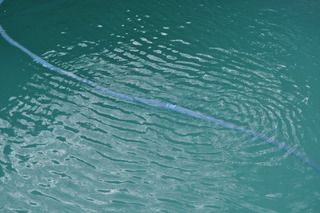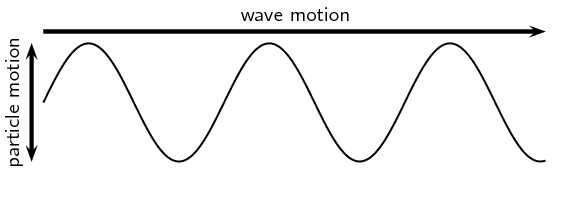8.2 What is a transverse wave?
|
Previous
8.1 Introduction
|
Next
8.3 Crests and troughs
|
8.2 What is a transverse wave?(ESACL)
Waves in a pool

We have studied pulses in Chapter 7, and know that a pulse is a single disturbance that travels through a medium. A wave is a periodic, continuous disturbance that consists of a train or succession of pulses.
An enlarged version of the ripple tank can be seen in a real life example of a Kreepy Krauly® making waves in a pool because of the regular vibrations. The Kreepy Krauly® was invented in South Africa by Ferdinand Chauvier and his son Daniel.
- Wave
-
A wave is a periodic, continuous disturbance that consists of a train of pulses.
- Transverse wave
-
A transverse wave is a wave where the movement of the particles of the medium is perpendicular (at a right angle) to the direction of propagation of the wave.
Transverse waves
Take a rope or slinky spring. Have two people hold the rope or spring stretched out horizontally. Flick the one end of the rope up and down continuously to create a train of pulses.

-
Describe what happens to the rope.
-
Draw a diagram of what the rope looks like while the pulses travel along it.
-
In which direction do the pulses travel?
-
Tie a ribbon to the middle of the rope. This indicates a particle in the rope.

-
Flick the rope continuously. Watch the ribbon carefully as the pulses travel through the rope. What happens to the ribbon?
-
Draw a picture to show the motion of the ribbon. Draw the ribbon as a dot and use arrows to indicate how it moves.
In the activity, you created waves. The medium through which these waves propagated was the rope, which is obviously made up of a very large number of particles (atoms). From the activity, you would have noticed that the wave travelled from one side to the other, but the particles (the ribbon) moved only up and down.

Figure 8.1: A transverse wave, showing the direction of motion of the wave perpendicular to the direction in which the particles move.
When the particles of a medium move at right angles to the direction of propagation of a wave, the wave is called transverse. For waves, there is no net displacement of the particles of the medium (they return to their equilibrium position), but there is a net displacement of the wave. There are thus two different motions: the motion of the particles of the medium and the motion of the wave.
The following simulation will help you understand more about waves. Select the oscillate option and then observe what happens.
|
Previous
8.1 Introduction
|
Table of Contents |
Next
8.3 Crests and troughs
|
